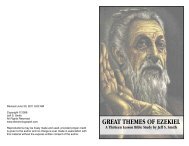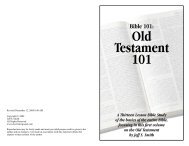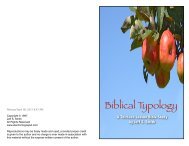New Testament Study Guides - ElectronicGospel
New Testament Study Guides - ElectronicGospel
New Testament Study Guides - ElectronicGospel
Create successful ePaper yourself
Turn your PDF publications into a flip-book with our unique Google optimized e-Paper software.
<strong>New</strong> <strong>Testament</strong> <strong>Study</strong> Guide: Letters to the Thessalonians<br />
NEW TESTAMENT STUDY GUIDES<br />
Rather than studying the <strong>New</strong> <strong>Testament</strong> verse-by-verse or in an<br />
overview, this series seeks to look at the letter according to its contexts–<br />
passage-by-passage, that is, by analyzing each of its paragraphs. Responses<br />
to the questions should be done on a separate sheet of paper and in shortanswer<br />
or essay format.<br />
INTRODUCTION<br />
The two letters are addressed to the saints in Thessalonica, the seaport<br />
capital of Macedonia and center of commerce, wealth and education. When<br />
Paul entered the city in A.D. 51, he found a large Greek element along with<br />
a slightly smaller population of Roman colonists. The Jews also inhabited<br />
the city and had at least one synagogue. Thessalonica had a wondrous<br />
amphitheater where gladiator contests were held, but the town’s general<br />
morals have been held in doubt for most of its history.<br />
According to Acts 17:1-10, the writer, the apostle Paul, helped to<br />
establish the congregation along with Titus in about A.D. 51. His tack was to<br />
remind them of the prophecies and show that Jesus fulfilled them. A few of<br />
the Jews were convinced and joined a larger number of devout Greeks and<br />
women. They were there for less than a month before a mob ran them out of<br />
town at the behest of the anti-Christian Jews.<br />
Both of these letters were likely written not long after Paul was expelled<br />
from Thessalonica, probably months apart in A.D. 51.<br />
Because the majority of the church had been converted out of paganism<br />
and lives of gross immorality, Paul felt it necessary to ground them further<br />
in the lessons of the cross. While applauding their steadfastness in the face<br />
of persecution, he encourages them to grow in holiness.<br />
The first letter remarks on a report Paul had received concerning the<br />
church in Thessalonica (3:6) and goes to great lengths to correct the deep<br />
misconceptions many apparently had about the return of Christ. It seems<br />
that some saints were so convinced that Jesus would return imminently that<br />
they had quit working and were dependent upon others to care for them.<br />
The second letter continues this theme and further encourages the<br />
Christians to endure their suffering while laboring to support themselves in<br />
an honorable fashion. The writer goes so far as to describe events which<br />
must occur before Jesus can return, including prophecy about an apostasy.









